North Fork
Bob - 2010
'09 maps for:
Bea
--
Buck -- Caley --
Claws --
Conomo --
Hix --
Hudson 09 -- Isabel --
Katy -- L.R. --
Moffet --
Mr. Hannah --
Ozzie --
Penelope
--
Rafael
2010 maps for: Belle -- Buck --
Gunny --
Hudson --
Mr. Hannah --
Neale --
North Fork Bob
--
Penelope --
Sanford
-- Sr. Bones --
Thatch
2011 maps:
Belle --
Buck --
Henrietta --
Katbird
-- North Fork Bob --
Pemi --
Saco --
Sanford --
Sr. Bones --
Snowy --
Thatch -- Tucker
2012 maps: Art --
Belle --
Bridger --
Chip --
Cutch --
Jill -- North Fork Bob --
Rammie --
Snowy --
Sr. Bones -- Thatch
2013 maps: Art --
Belle --
Bridger --
North Fork Bob --
Rammie --
Snowy --
Sr. Bones
Osprey
main page --
Migration
page --
Migration09 --
Migration10 --
Migration 11 --
Migration 12 --
Migration 13 -- Home
Page
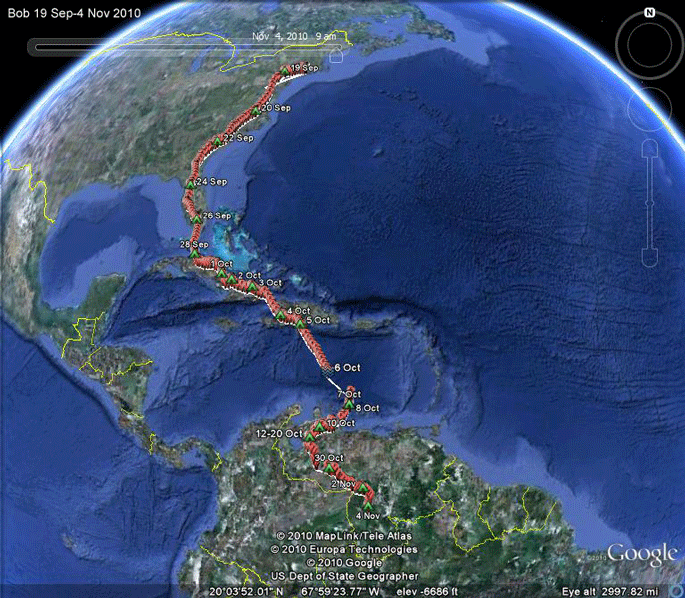 |
North Fork Bob is in the Amazon basin. Bob headed south on the 19th of
September. He
had clear sailing and good winds all the way down to Florida, where we
last heard from him on the 25th. He moved pretty steadily towards his final destination (known to him, but not us). He got to Aruba on the 7th of October, spent a day there, and then moved on to Venezuela. After about 10 days at what looked like a final wintering stop, he moved again on the 28th of October. He's now in the Venezuelan state of Amazonas, and seems to be heading south. Scroll down for detailed maps of pre-migration movement, or jump to the start of fall migration. |
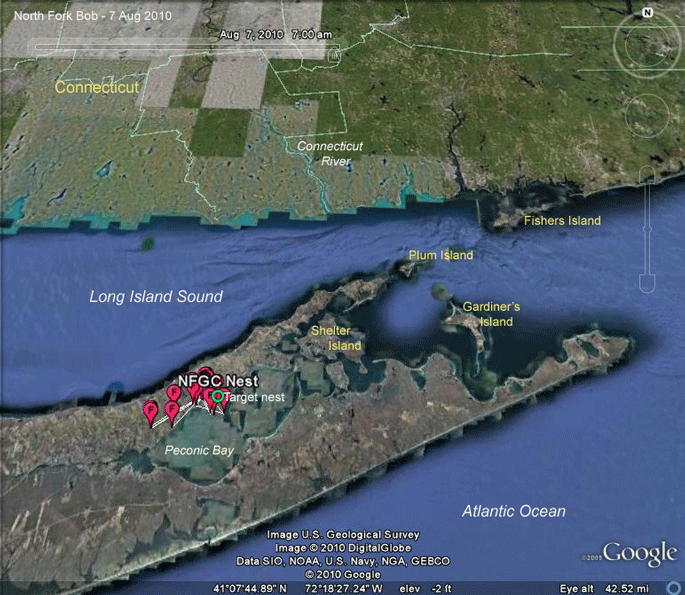 |
The first few days: 7 August. This part of Long Island and the
southeastern Connecticut coast were once the epicenter of the coastal
New England Osprey population, with some 300 pairs nesting on Gardiner's
Island alone--the densest concentration for the species anywhere on the planet
then or since. We trapped "North Fork Bob" at the green circle on this map. He has not been back since and seems to be focused on an area nearby, suggesting that he is a sneak thief, who saw the fish in the nest beneath our noose carpet and figured that if the resident pair didn't want it, he wasn't about to let that fancy Mediterranean fish go to waste! He got a fancy new GPS backpack transmitter (and no fish) for his efforts. That'll teach him. |
 |
The first few days: 7 August. Here's a closer view of the movements of our light-taloned male. He was caught with his talons in the cookie jar at the NFGC nest, which it seems is his neighbor's place. He hasn't been back since. There is no nest apparent where he spends much of his time, so it appears this is probably a non-breeding male. Perhaps a young bird on his first return to his breeding area. |
 |
6-14 Aug 2010. We figured out what happened with North Fork Bob. He
keeps returning to one spot behind a couple of buildings. Some
investigation revealed that Bob and a mate had had a nest on a
cell-phone tower for the past two years. This spring the owner of the
cell tower had the nest removed. Bob seems to be doing most of his hunting out in Peconic Bay. |
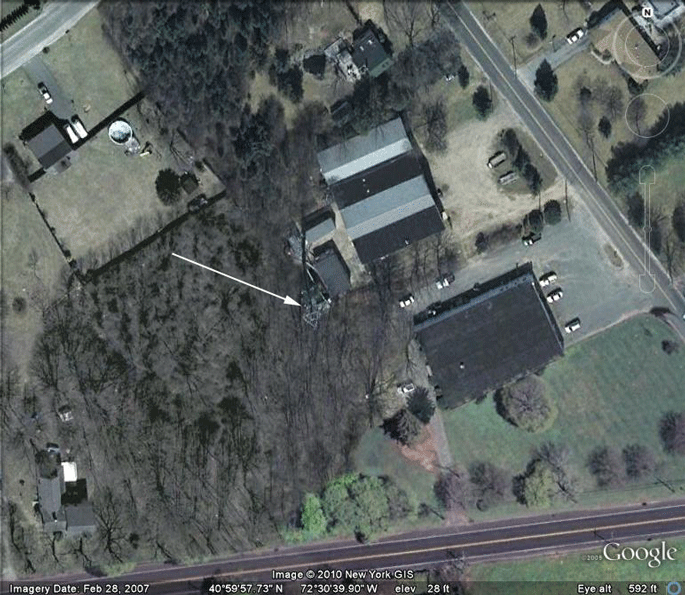 |
Bob's locations showed him coming back exactly to this spot over and over again. It made no sense, unless it was a nest. But the local experts didn't know of a nest here. Tim Perry, one of the Osprey faithful on Long Island, who was on hand to photograph Bob's capture and tagging, went out to this spot and talked to the people who work in the buildings here. Tim discovered that for the past 2 years a pair of Ospreys had been nesting on a cell-phone tower at this site. This is the best image we can get from Google Earth. Scroll down! |
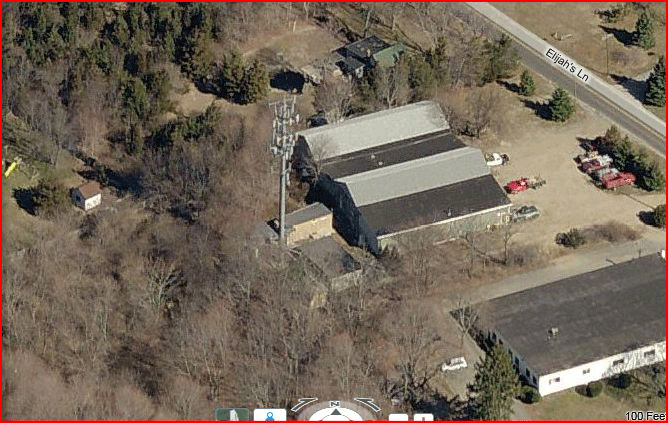 |
The totally unbelievable Bing Maps site offers this
view of the nest site. I am as deeply embedded in the Mac world as one
can be, having used Apple computers ever since my first Apple Plus ][
back in 1981, so I don't give praise to the MicroSoft Universe often,
but these Bing Maps images are off-the-charts incredible. Unfortunately, Tim learned that the owner of the tower had Bob's nest knocked down this spring. If Bob makes it through the winter migration (usually about 80-90% chance for adults), he should try to nest here again next spring. Hopefully, we'll be able to convince the tower owner to let the birds complete their nesting cycle in 2011. |
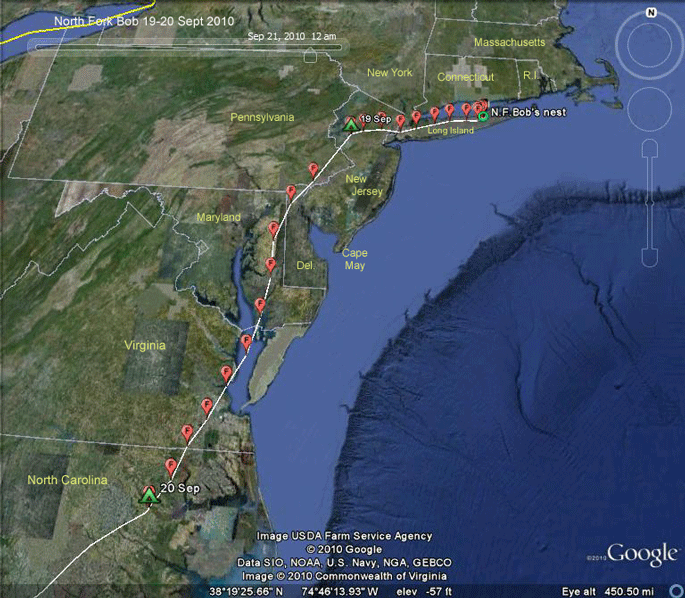 |
19-20 Sep 2010. Bob started his
migration on the 19th around 9:30 AM. He flew pretty much due
west for about 9 hours, roosting in northwestern New Jersey, 124 miles
(200 km) from home. On the 20th he really got into it, flying through six states, covering 354 mi. (570 km). He probably took off before 7 AM and flew about 12 hours, settling down around dusk in northeastern North Carolina. |
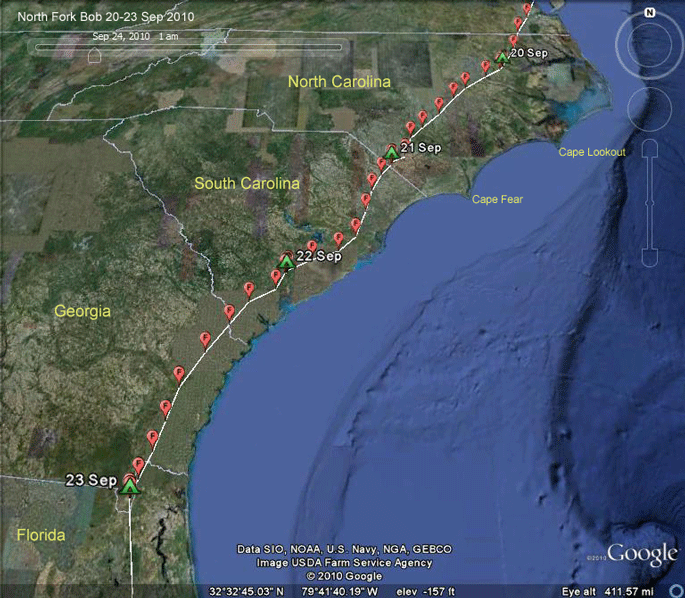 |
20-23 Sep 2010. No news here--just plugging away following in the
path of countless other Ospreys over the generations. He began his migration each of these days just before 10AM, which suggests he may be doing some fishing before starting off or waiting for thermals to develop. |
 |
23-26 Sep 2010. I've put the routes of all the other Ospreys we've
been following this year on the map along with Bob's track. Once into the northeastern corner of Florida, there's no real geographic feature that would funnel birds through any given area, so they just seem to drift south. All but one (and this is typical over the years) wound up flying over the Everglades and Florida Keys before making the crossing to Cuba. |
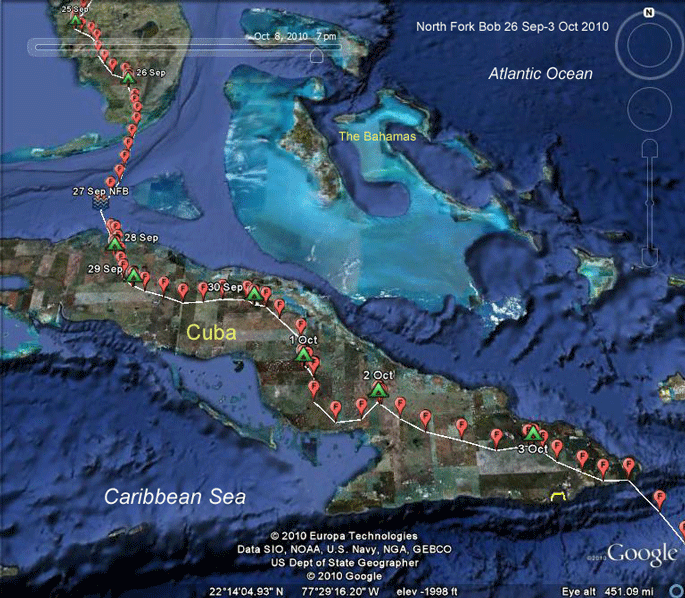 |
26 Sep-3 Oct 2010. Fairly slow progress through Cuba here-only 4-5 hours of moving each day (count the markers-each is an hour after the last). |
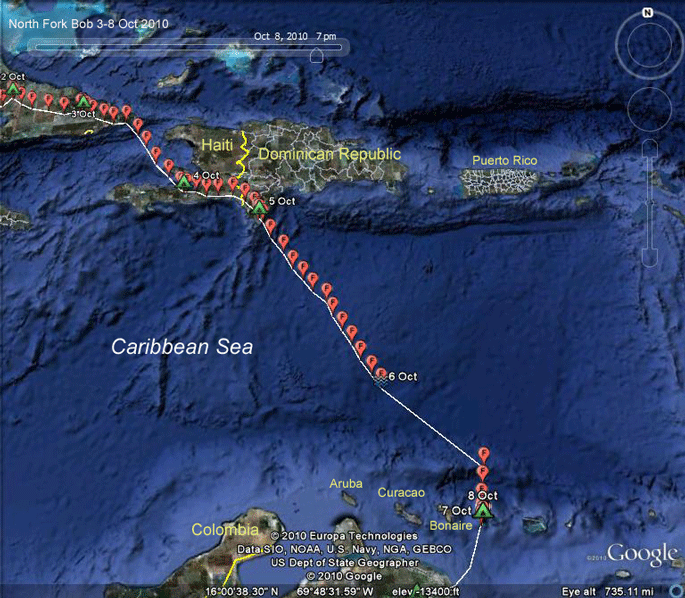 |
3-8 Oct 2010. Bob began this leg of his migration just after 8AM on
the 5th and was out over the Caribbean before 9. Twelve hours later he
was well over half way to his next rest stop. The trip was at least 485 miles (781 km). (I say it was at least that distance because we are not sure exactly what route he took when the GPS unit was off for 12 hours. This is always the case when birds are moving while their GPS units are off. In this case, however, the tracks suggest we won't be far off.) His average speed over the crossing was 18 miles (30 km)/hour. |
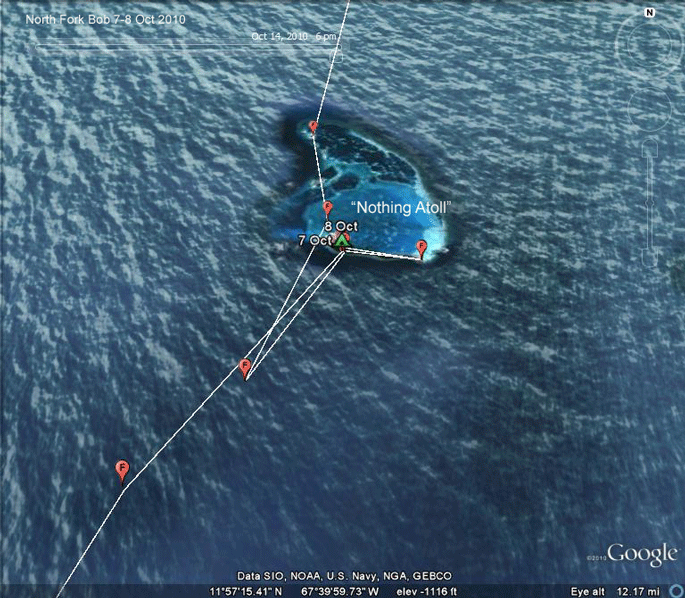 |
8-9 Oct 2010. This tiny atoll just east of Bonaire was a good
resting spot for Bob. He started south on the 7th and then retreated to
spend the 8th on the atoll. He left on the 9th and apparently had clear
sailing all the way to the coast. (The island really is not called Nothing Atoll--I just named it that in homage to the wit of the Rocky and Bullwinkle show.) |
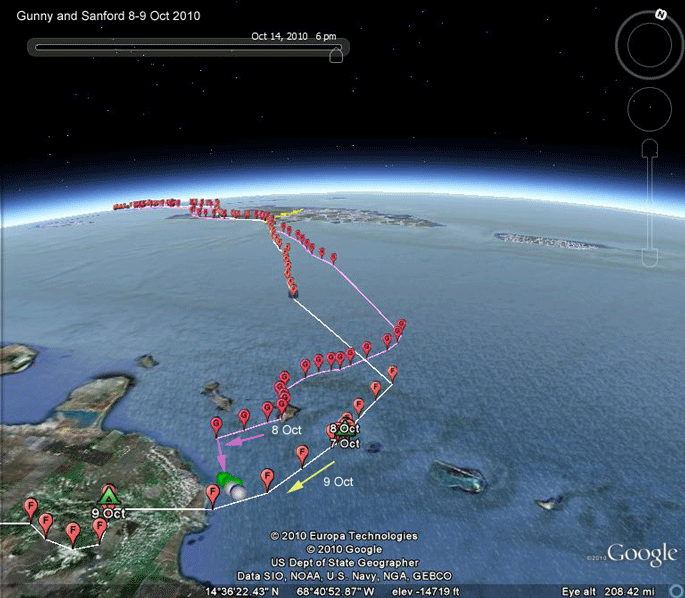 |
8-9 Oct 2010. Bob's aborted departure from his rest stop on "Nothing
Atoll" suggests that the weather was bad. He did not travel on the 8th,
while Gunny did attempt the relatively short crossing on that day and
did not make it. He was only 20 miles from Venezuela when we got his
last GPS fix. The colored dots are non-GPS signals from Gunny's
transmitter the next day, when presumably his body was drifting in the
sea. This highlights the danger of overwater crossings and explains why Ospreys island-hop their way across the Caribbean as much as they possibly can. Very glad Bob decided to sit it out on the 8th! |
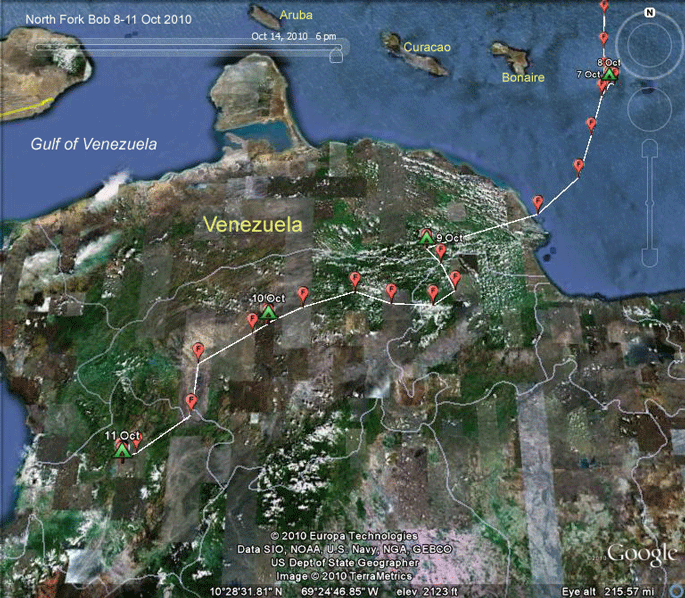 |
9-11 Oct 2010. This is what we've come to recognize as typical
behavior when adults reach South America. They hit the shore somewhere
(probably determined by winds as they crossed the Caribbean, and then
take off in a pretty straight line for their wintering grounds. The detour Bob took on the 10th may have been avoiding some mountainous terrain. |
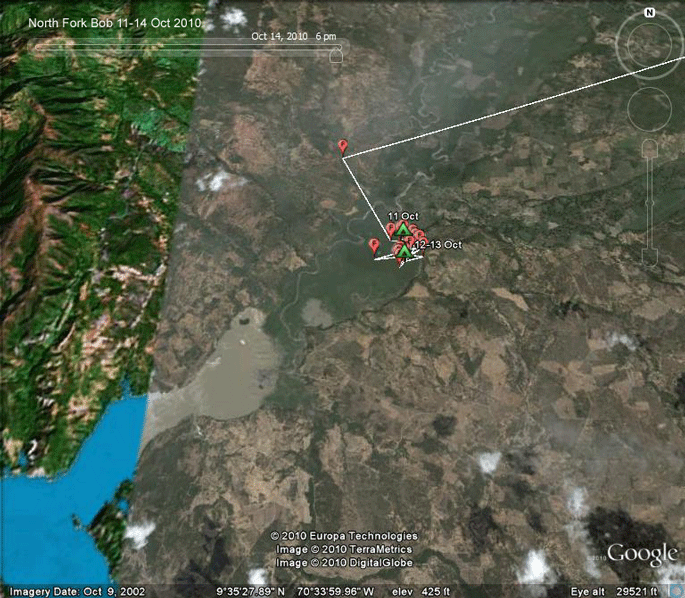 |
11-14 Oct 2010. This sort of has the feel of a bird returning to his
wintering grounds. Fairly fast and directed movement and then a sudden
stop in a very localized area. Stay tuned. The Osprey-ometer readings: Distance traveled: 3110 mi (5005 km). Average distance moved on migration days (1 day stopover excluded): 141 miles (228 km). |
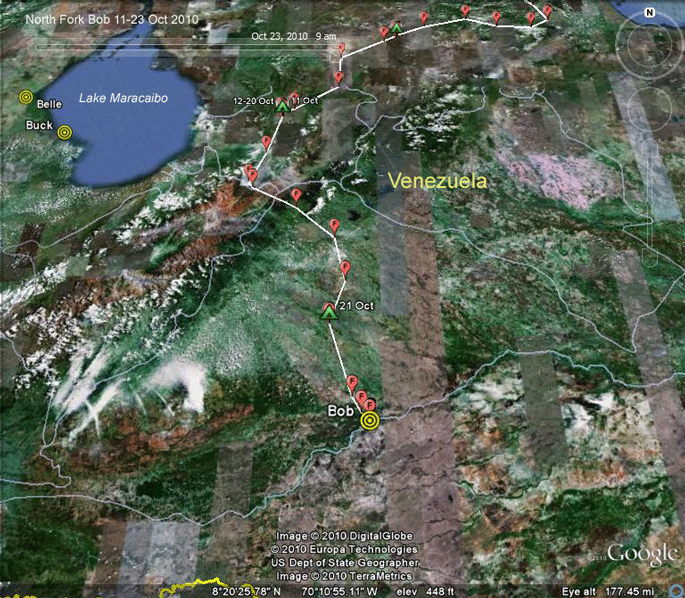 |
11-23 Oct 2010. Bob is on the move again after a 10-day layover.
Most likely this was a refueling stop. He arrived on the Apure River on the 22nd and settled down there for a week. The current locations for Belle ('10 Juv) and Buck ('09 Juv) are indicated. Buck should be coming home in about 5 months. |
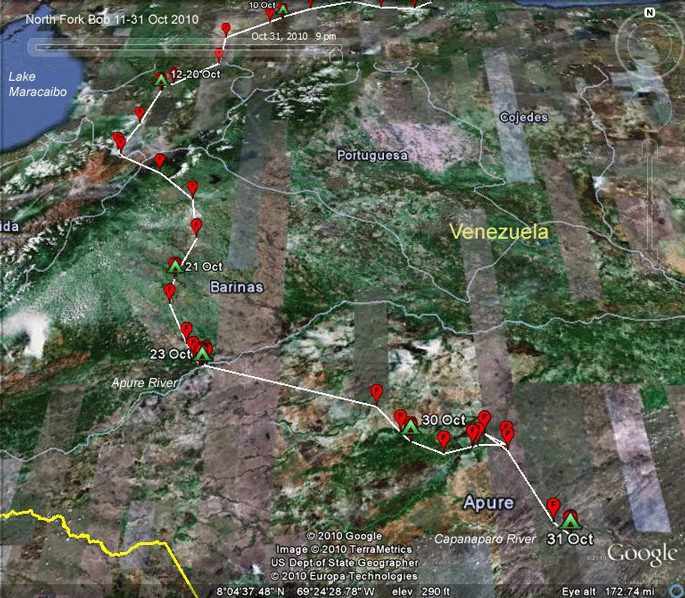 |
24-31 Oct 2010. Bob is poking around the Venezuelan landscape much like Mr. Hannah and Hudson did last year. |
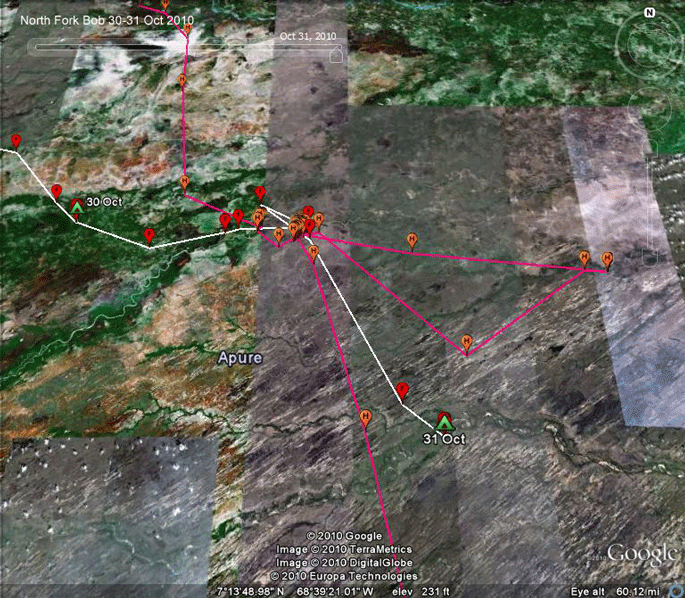 |
30-31 Oct 2010. Here are Bob's most recent locations along with those of Mr. Hannah, our Nantucket bird who spent time in this same area back in early October of 2009. |
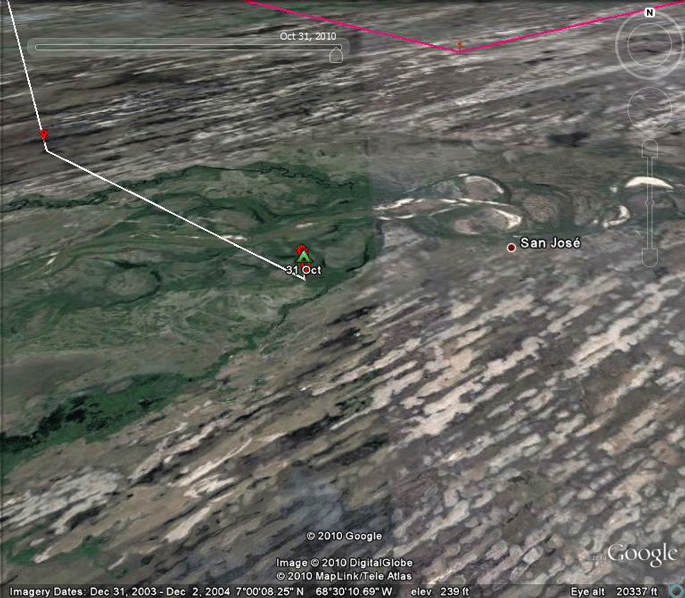 |
31 Oct 2010. Here's a closer view of the strange landscape in the Venezuelan state of Apure. The striations are large sand dunes (medanos), whose origin is a matter of some debate, but are probably sand blown up off beaches newly exposed by the meandering rivers in the area. |
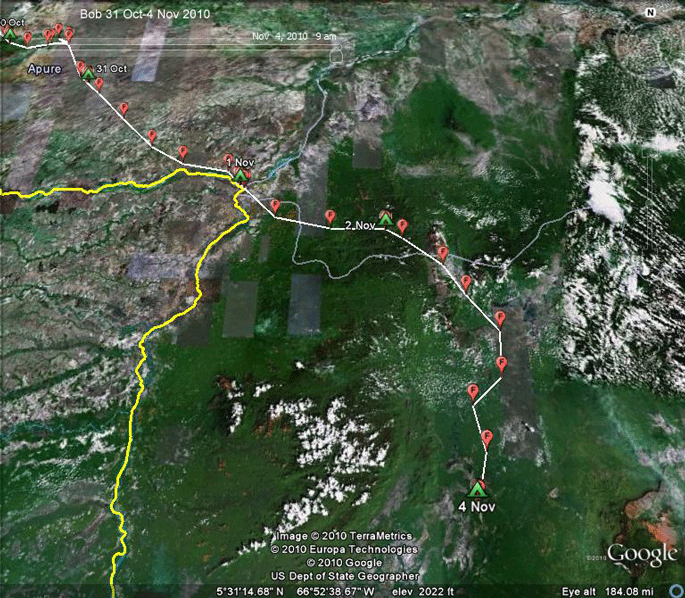 |
4 Nov 2010. Bob is pushing south and has now moved into the northern limits of the Amazon basin. |
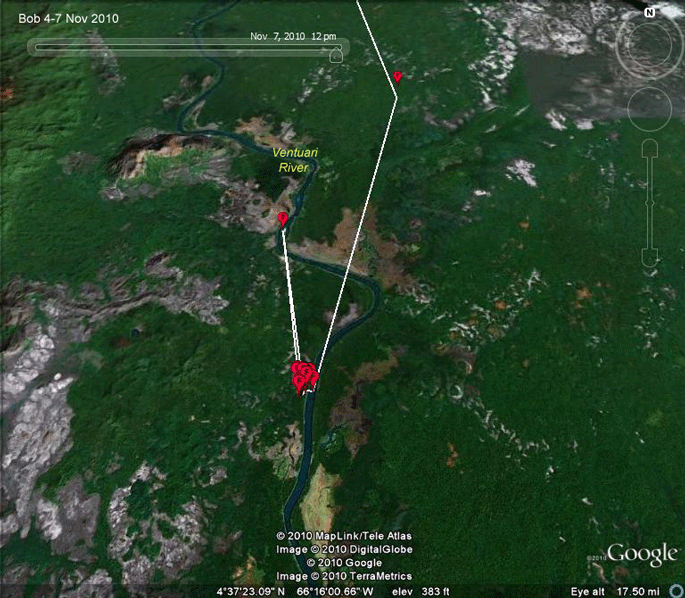 |
4-7 Nov 2010. Bob has settled down for a few days here. Is this the
end of his migration? I thought he was done a few weeks back. It
is getting late for an adult not to have arrived at his wintering
grounds. The area seems to be suffering quite a bit of deforestation. |
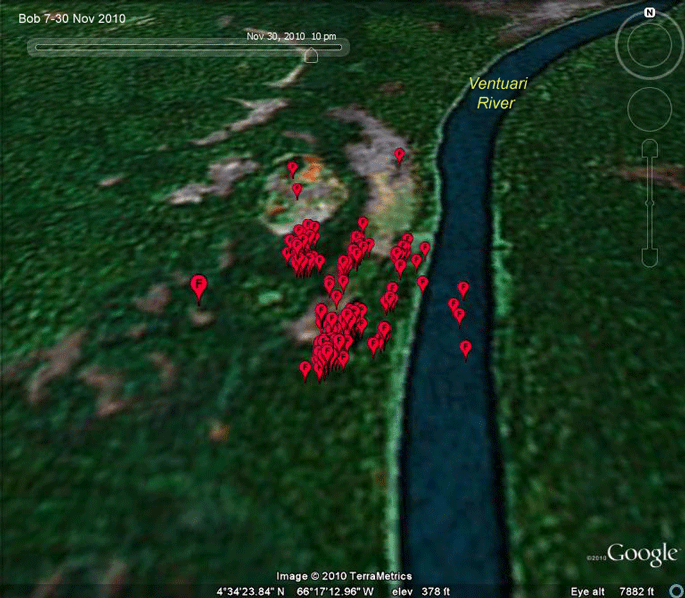 |
7-31 Nov 2010. Bob has definitely settled down. This is as tight a collection of points as we've seen from a wintering Osprey. The farthest points in this 3-week cluster are only 0.6 miles (1 km) apart. |
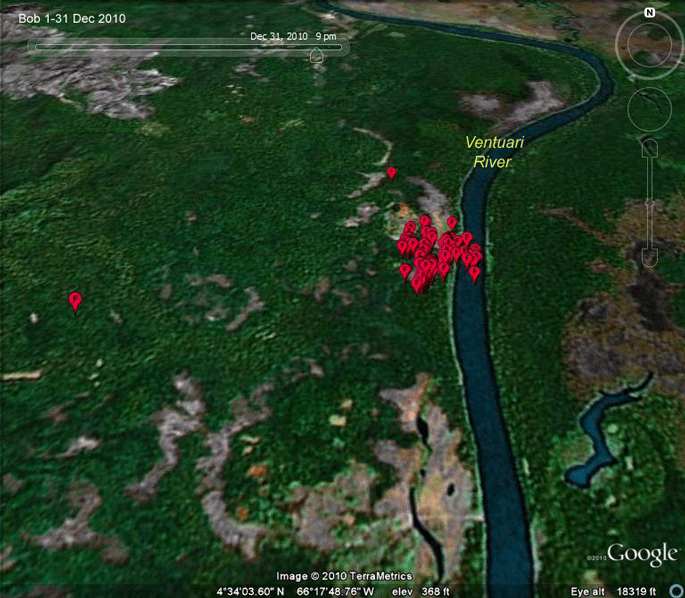 |
1-31 Dec 2010. Bob made one foray a whopping 2.5 miles west of his winter home. |
Birds of Prey page -- Osprey main page -- Migration page -- Home Page